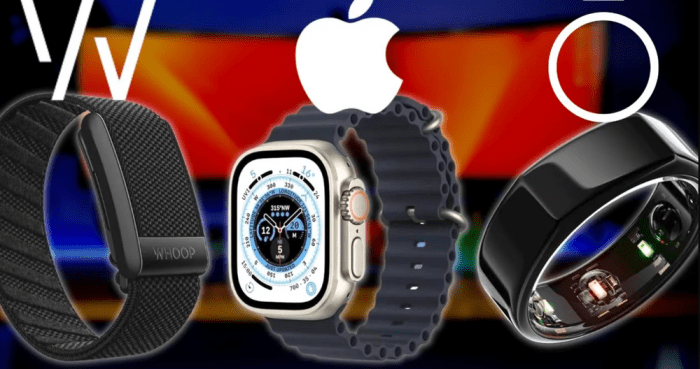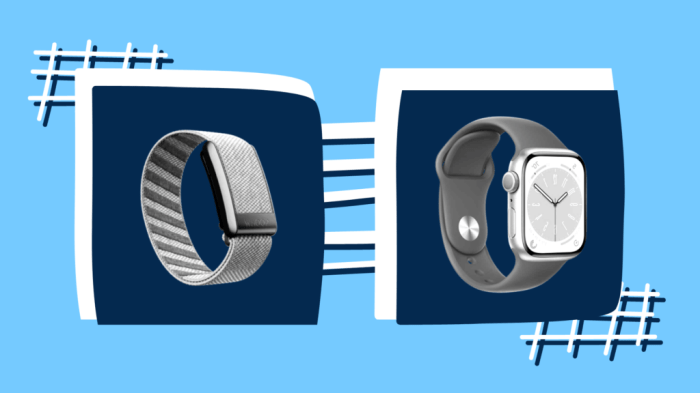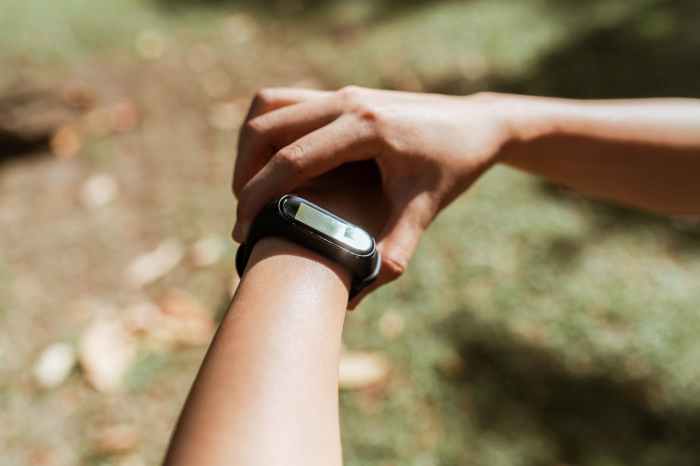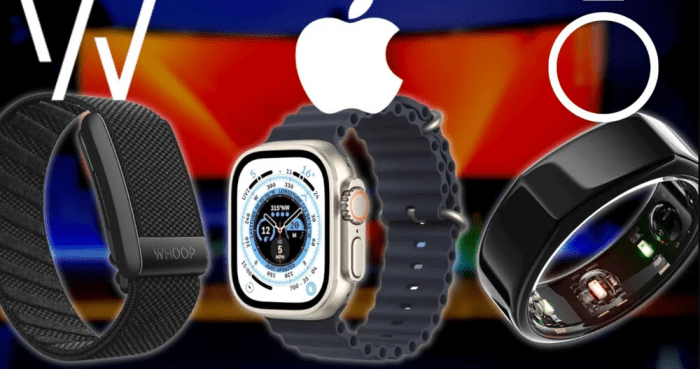
Apple Watch vs Whoop: Which Fitness Tracker Is Right for You?
Apple Watch vs Whoop: These two titans of the wearable fitness tracker world are constantly battling for supremacy in the hearts and wrists of health-conscious individuals. Both offer a wealth of features, from tracking your workouts and sleep to monitoring your heart rate and even your recovery.
But with so many similarities, how do you choose the right one for you?
In this blog post, we’ll dive deep into the features, design, compatibility, and price of both Apple Watch and Whoop, exploring their strengths and weaknesses to help you make an informed decision. Whether you’re a seasoned athlete looking to optimize your performance or a casual fitness enthusiast aiming to improve your overall health, this comprehensive comparison will guide you towards the wearable that aligns best with your needs and goals.
Introduction
The world of wearable technology is rapidly evolving, with fitness trackers and smartwatches becoming increasingly popular. Two prominent players in this space are the Apple Watch and Whoop, each offering a unique set of features and targeting different demographics. The growing popularity of wearable fitness trackers can be attributed to the increasing emphasis on health and wellness.
Consumers are increasingly seeking comprehensive health monitoring solutions that provide insights into their fitness levels, sleep patterns, and overall well-being. When choosing a wearable device, consumers consider several factors, including price, features, and compatibility. The Apple Watch, with its sleek design and comprehensive app ecosystem, appeals to a broad audience.
Whoop, on the other hand, focuses on performance optimization and data-driven insights, attracting athletes and fitness enthusiasts.
Factors Considered When Choosing a Wearable Device
Consumers consider several key factors when choosing a wearable device, including:
- Price:Wearable devices range in price from budget-friendly options to high-end models. The price point often reflects the features and functionality offered. For example, the Apple Watch Series 8 starts at $399, while the Whoop 4.0 costs $30 per month for a subscription-based service.
- Features:The features offered by a wearable device are crucial for meeting individual needs. Some common features include heart rate monitoring, GPS tracking, sleep tracking, and fitness tracking. The Apple Watch offers a wide range of features, including cellular connectivity, ECG monitoring, and fall detection.
Whoop focuses on advanced metrics like heart rate variability (HRV), recovery time, and sleep quality.
- Compatibility:Compatibility with smartphones and other devices is essential for seamless integration and data sharing. The Apple Watch is compatible with iPhones, while Whoop is compatible with both iOS and Android devices.
- Design and Aesthetics:The design and aesthetics of a wearable device are also important considerations. The Apple Watch is known for its sleek and stylish design, while Whoop’s strap-like design is more functional and discreet.
Features and Functionality

Both Apple Watch and Whoop are popular wearables for fitness tracking, but they cater to different needs and offer distinct features. Apple Watch is a more versatile smartwatch with a wide range of apps and functionalities, while Whoop focuses specifically on fitness and recovery data.
This comparison delves into their core features, highlighting their strengths and weaknesses, and examining their differences in sensor technology, data accuracy, and overall performance.
Workout Tracking
Apple Watch and Whoop both excel in workout tracking, but their approaches differ. Apple Watch offers a comprehensive suite of workout modes, including running, cycling, swimming, and strength training. It uses GPS for accurate distance and pace tracking, while its heart rate sensor provides detailed metrics for intensity and calorie burn.
Apple Watch excels in its variety of workout modes, but its GPS accuracy can vary, especially in dense urban environments.
Whoop, on the other hand, focuses on providing a deeper understanding of workout effort and recovery. It uses its proprietary strain score to measure the intensity of workouts and their impact on the body. Whoop’s strain score is calculated based on heart rate, heart rate variability, sleep quality, and other factors.
Whoop’s strain score provides valuable insights into workout intensity and recovery, but it lacks the detailed workout metrics offered by Apple Watch.
Sleep Monitoring
Sleep tracking is a crucial aspect of fitness and recovery, and both Apple Watch and Whoop offer dedicated sleep monitoring features. Apple Watch uses its heart rate sensor and movement data to track sleep stages (light, deep, REM), duration, and wake-up times.
Apple Watch’s sleep tracking is convenient, but its accuracy can be impacted by movement during sleep.
Whoop takes a more advanced approach, using its proprietary algorithm to track sleep stages, heart rate variability, and respiratory rate. It also provides insights into sleep quality and recovery based on these metrics.
Whoop’s sleep tracking provides a more comprehensive understanding of sleep quality and recovery, but it may require some adjustment to its sleep stage classification compared to traditional methods.
Heart Rate Variability
Heart rate variability (HRV) is a key indicator of overall health and recovery. Apple Watch tracks HRV, but it’s not a primary focus. It provides basic HRV data in the Health app, but it lacks detailed analysis or insights.
Apple Watch offers basic HRV data, but it lacks the in-depth analysis and personalized insights provided by Whoop.
Whoop prioritizes HRV analysis, using it to calculate its strain score and provide personalized recovery recommendations. It provides detailed HRV data and insights, including trends over time and the impact of sleep, exercise, and stress.
Whoop’s focus on HRV provides valuable insights into recovery and overall health, but its data interpretation can be complex for beginners.
Choosing between an Apple Watch and a Whoop for fitness tracking is a tough call, but with the recent news of google passkeys chrome android , I’m wondering if a future wearable might be able to combine the best of both worlds – detailed sleep tracking and a user-friendly interface, all secured by a next-gen authentication system.
Now that’s something I’d wear with pride!
Design and User Experience
Both Apple Watch and Whoop are designed for fitness tracking and health monitoring, but they differ significantly in their aesthetics and user experience. While Apple Watch prioritizes a stylish and customizable design, Whoop focuses on discreet and data-driven functionality.
Design Aesthetics and Ergonomics
The Apple Watch is available in various styles and materials, catering to diverse preferences. Its square-shaped display, sleek aluminum, stainless steel, or titanium casing, and interchangeable bands offer a wide range of customization options. The Whoop, on the other hand, has a minimalist and discreet design.
Its small, round, and black-colored band with a hidden sensor module blends seamlessly with everyday attire.
- Apple Watch: Offers a wide range of styles, materials, and customizable features, making it a fashion statement. Its square-shaped display provides a larger screen area for viewing information and navigating menus.
- Whoop: Prioritizes discreetness and comfort with a small, round, and black-colored band, making it suitable for all-day wear. Its minimalist design and hidden sensor module ensure a seamless and unobtrusive experience.
User Interface and Navigation
Apple Watch boasts a comprehensive and intuitive user interface. Its touch-sensitive display allows for smooth navigation through menus and apps using swipes, taps, and the digital crown. The interface is customizable with various watch faces, widgets, and app layouts. Whoop’s user interface is primarily focused on data visualization and insights.
Its minimalist design features a simple and straightforward navigation system, prioritizing data accessibility and ease of use.
- Apple Watch: Features a comprehensive and intuitive user interface with customizable watch faces, widgets, and app layouts, offering a personalized experience. Its touch-sensitive display enables smooth navigation through menus and apps using swipes, taps, and the digital crown.
- Whoop: Prioritizes data visualization and insights with a minimalist user interface. Its simple and straightforward navigation system ensures ease of use and quick access to essential information.
Battery Life and Charging Capabilities
Apple Watch’s battery life varies depending on usage patterns and features enabled. Typically, it can last for a full day with moderate usage, including fitness tracking, notifications, and music playback. Charging is done wirelessly using a magnetic charging puck. Whoop boasts a longer battery life, lasting up to 4-5 days on a single charge.
It utilizes a proprietary charging cable that connects to the band’s sensor module.
- Apple Watch: Offers a full day of battery life with moderate usage, requiring daily charging using a wireless magnetic charging puck. Its battery life can vary depending on usage patterns and enabled features.
- Whoop: Provides a longer battery life of 4-5 days on a single charge, eliminating the need for frequent charging. It uses a proprietary charging cable that connects to the band’s sensor module.
Compatibility and Connectivity: Apple Watch Vs Whoop

Both Apple Watch and Whoop are designed to work with smartphones, but they have different compatibility requirements and offer distinct app ecosystems and data sharing capabilities.
Smartphone Compatibility
Apple Watch requires an iPhone to function, making it incompatible with Android devices. The Apple Watch Series 8, for instance, is compatible with iPhones running iOS 16 or later. In contrast, Whoop is compatible with both iOS and Android devices.
Whoop 4.0, for example, is compatible with iPhones running iOS 13 or later and Android phones running Android 8.0 or later.
App Ecosystems
The Apple Watch’s app ecosystem is significantly larger than Whoop’s, with a vast library of apps available on the Apple App Store. This allows for a wider range of customization and integration with other fitness and health apps. For example, Apple Watch users can access apps like Strava, Nike Run Club, and MyFitnessPal to track their workouts, analyze their performance, and manage their nutrition.
Whoop, on the other hand, focuses on its proprietary app, which provides detailed sleep, recovery, and workout insights. While it integrates with some third-party apps, such as Apple Health and Google Fit, the integration is limited compared to the Apple Watch.
Whoop’s app provides comprehensive data analysis and personalized recommendations based on your individual metrics.
Data Sharing Capabilities
Apple Watch seamlessly integrates with Apple Health, allowing users to share their data with other health and fitness apps that support Apple Health integration. This enables a holistic view of your health and fitness data across different platforms. Whoop offers limited data sharing capabilities.
The debate between Apple Watch and Whoop is all about what you prioritize: style or data? If you’re looking for a device that complements your summer wardrobe, then you might want to check out the Tory Burch summer capsule collection for some chic and stylish options.
But if you’re serious about tracking your sleep and recovery, then Whoop might be the better choice for you. Ultimately, it’s all about finding the right fit for your individual needs and preferences.
While it can export data in CSV format, it doesn’t directly integrate with other fitness apps as seamlessly as Apple Watch. However, Whoop’s data can be used to create custom visualizations and insights using tools like Google Sheets or Excel.
Price and Value
Both Apple Watch and Whoop offer fitness trackers with varying features and price points. Understanding the cost structure and value proposition of each device is crucial for making an informed decision.
Apple Watch Pricing and Value
Apple Watch pricing varies significantly depending on the model, size, materials, and cellular connectivity. The base model, Apple Watch Series 8, starts at $399 for the GPS version and $499 for the cellular version. Higher-end models, like the Apple Watch Ultra, can cost upwards of $799.The Apple Watch offers a wide range of features, including:
Fitness tracking
Heart rate monitoring, step counting, GPS tracking, workout detection, and sleep tracking.
Health monitoring
ECG, blood oxygen monitoring, fall detection, and emergency SOS.
Smartwatch functionality
Notifications, app support, music playback, Siri voice assistant, and mobile payments.The Apple Watch is a versatile device that caters to a broad audience, from casual fitness enthusiasts to serious athletes. Its high price tag reflects its premium design, robust functionality, and comprehensive ecosystem.
Whoop Pricing and Value, Apple watch vs whoop
Whoop is a subscription-based fitness tracker that focuses on providing personalized insights and performance optimization. The device itself costs $300, but requires a monthly subscription starting at $30.Whoop’s value proposition lies in its data-driven approach to fitness. It provides:
Advanced sleep analysis
Sleep stages, heart rate variability, and respiratory rate.
Recovery metrics
Strain, recovery, and sleep quality.
Personalized insights
Training recommendations, sleep optimization tips, and performance analysis.Whoop’s subscription model provides access to its comprehensive data analysis and coaching features. It is ideal for individuals seeking detailed insights into their fitness and recovery.
Choosing between an Apple Watch and a Whoop can be a tough decision, especially if you’re a fitness enthusiast who values both style and data. But sometimes, a break from the tech world is just what you need. A fun DIY project like making a feather butterfly wreath can be a relaxing way to de-stress and add a touch of whimsy to your home.
Then, after your creative session, you can jump back into the fitness tracker debate with renewed energy!
Overall Cost of Ownership
The overall cost of ownership for both devices depends on the chosen model, subscription fees, and accessory costs.| Device | Initial Cost | Monthly Subscription | Accessory Costs ||—|—|—|—|| Apple Watch Series 8 (GPS) | $399 | $0 | Variable || Apple Watch Series 8 (Cellular) | $499 | $0 | Variable || Whoop | $300 | $30+ | Variable |Apple Watch offers a one-time purchase with no recurring fees, while Whoop requires a continuous monthly subscription.
Accessory costs for both devices can vary depending on the desired features, such as straps, chargers, and protective cases.
Target Audience and Use Cases

Both Apple Watch and Whoop are wearable fitness trackers that offer a range of features for health and fitness monitoring. However, their target audiences and use cases differ due to their distinct features and functionalities.
Apple Watch: A Versatile Wearable for a Broad Audience
The Apple Watch is a popular choice for a diverse range of users, from casual fitness enthusiasts to professional athletes. Its versatility stems from its wide array of features, including fitness tracking, health monitoring, communication, and entertainment.
- Fitness Enthusiasts and Athletes:The Apple Watch provides comprehensive fitness tracking capabilities, including GPS, heart rate monitoring, and activity tracking. It’s a valuable tool for athletes who want to monitor their performance, set goals, and track their progress. Its advanced features like ECG and blood oxygen monitoring can also benefit athletes who want to understand their physiological responses during training.
- Casual Users:Apple Watch’s intuitive interface, sleek design, and user-friendly features make it appealing to casual users who want to track their steps, calories burned, and sleep patterns. Its integration with other Apple devices and apps enhances its appeal for everyday use.
- Health-Conscious Individuals:The Apple Watch’s health monitoring features, such as heart rate variability, sleep analysis, and fall detection, make it a valuable tool for individuals who are proactive about their health. It can help them identify potential health concerns and make informed decisions about their well-being.
Whoop: A Focused Tool for Performance Optimization
Whoop is specifically designed for athletes and fitness enthusiasts who want to optimize their performance and recovery. Its focus on sleep, strain, and recovery metrics makes it a powerful tool for understanding how different activities impact the body’s ability to perform.
- Serious Athletes:Whoop’s detailed sleep and recovery data can be highly valuable for athletes who train intensely and need to optimize their performance. It can help them identify areas where they can improve their training and recovery strategies to maximize their potential.
- Fitness Enthusiasts:Whoop can also be a valuable tool for fitness enthusiasts who want to take their training to the next level. By understanding their recovery status, they can adjust their workouts accordingly and avoid overtraining, which can lead to injuries and plateaus.
- Health-Conscious Individuals:While Whoop’s primary focus is on performance optimization, its sleep tracking data can also be beneficial for individuals who want to improve their sleep quality and overall well-being. It can help them identify factors that are affecting their sleep and make adjustments to their lifestyle accordingly.
Benefits and Drawbacks for Different User Groups
- Athletes:For athletes, the Apple Watch provides a comprehensive fitness tracking experience with advanced features like ECG and blood oxygen monitoring. However, Whoop’s focus on sleep, strain, and recovery data might be more valuable for athletes who want to optimize their performance and recovery.
- Fitness Enthusiasts:Apple Watch’s versatility and wide range of features make it appealing to fitness enthusiasts who want to track their progress and stay motivated. However, Whoop’s data-driven approach and focus on recovery metrics can be more beneficial for those who want to take their training to the next level.
- Casual Users:The Apple Watch’s user-friendly interface and wide range of features make it a suitable choice for casual users who want to track their activity levels and stay connected. However, Whoop’s focus on performance optimization might not be as relevant for casual users.
Pros and Cons
Choosing between an Apple Watch and a Whoop fitness tracker can be challenging, as both offer unique benefits. To help you make an informed decision, we’ve compiled a comprehensive table outlining the pros and cons of each device.
Comparison of Apple Watch and Whoop
This table provides a side-by-side comparison of the Apple Watch and Whoop, highlighting their key advantages and disadvantages across various features.


